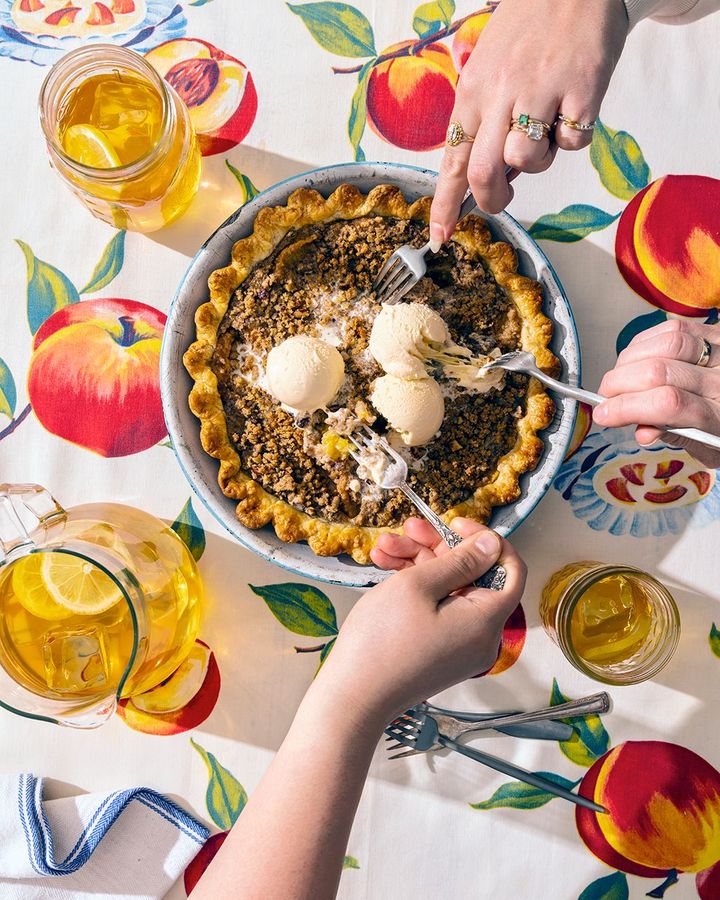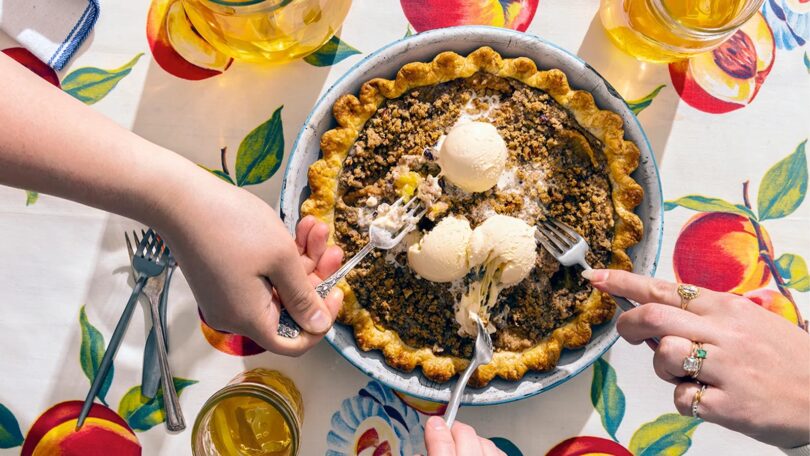Rachel Phua
“Bye-bye, Miss American Pie” – the Don McLean song that epitomised ’70s America, may have been a melancholic one, but the buttery, crusty delight it references gives people much more cheer.
Pies were likely invented in 2nd Century BCE by the ancient Egyptians or Romans, and popularized by the British in the 16th Century, but they are now synonymous with American cuisine, thanks to the Thanksgiving holiday and pop culture.
America’s obsession with pie is what inspired Stacey Mei Yan Fong, author of the new cookbook, 50 Pies, 50 States: An Immigrant’s Love Letter To The United States Through Pie (released June 2023) to bake pie after pie to commemorate the country. “I feel like what better way for me to fully immerse myself and learn about the country that I’ve chosen to call home than through food? And I feel like there’s nothing more American than pie.”
Fong was born in Singapore and grew up in Indonesia and Hong Kong. She moved to Savannah, Georgia, to study at the Savannah College of Art and Design. After graduating in 2010, she moved to New York City to work in fashion.
In 2015, Fong hit a rough patch. There was permanent residency to apply for, her grandmother died, and her housemate of seven years was moving out. She said she needed something that would “tether” her to her chosen home.
A year later, Fong started the “50 Pies, 50 States” project, creating and documenting her pie recipes on her website — one pie representing each US state, each one inspired by facts or ingredients for which the state was known. It took her about five years to finish the project, given the time needed to research each state and experiment with her recipes, as well as taking a year’s pause during the pandemic.
Fong would give each pie to friends she knew who came from the state. It was her way of saying “I love you” without actually articulating the words. “It’s a very Singaporean thing where you don’t really tell somebody that you love them… but you do it by feeding them,” she said with a laugh. Friends have been what makes the US her home, she said.
One of the pies most special to Fong is her Georgia Sweet Tea Peach Pie. It’s a dedication to the state of Georgia, which she said, “helped me come out of my shell”. The pie is also a nod to her best friend and housemate, who is from Georgia.
Georgia has long been known as the Peach State. The fruit was first introduced by Franciscan monks to islands along Georgia’s coast in the 16th Century, and were cultivated by member of the Cherokee Native American tribe about two centuries later. The state’s humid climate and clay soil provide optimal growing conditions. Peaches became Georgia’s official state fruit in 1995.
To add her own spin on the traditional peach pie, Fong replaced the sugar with a sweet-tea syrup, a nod to the drink served with almost every meal in the American south. To add more character – and sweetness – she topped the pie with a crunchy, buttery brown sugar pecan crumble. Pecans are another staple in Georgia, and account for about one-third of total American pecan production.
Fong said the pie is “not for the faint of heart”, referring to people without a sweet tooth. But the pie’s sweetness is meant to “encompass this whole idea of Southern hospitality” and how Fong felt when she moved from a big city to a small town when she was 18.
“When I first moved to Georgia, it was a huge, huge change from Hong Kong. But everybody there welcomed me with open arms,” she said, adding that the friends she made in college are still her friends today. Georgia, she says, is “a real peach”.
Sweet Tea Peach Pie with Pecan Crumble is a dedication to the state of Georgia (Credit: Alanna Hale)
Sweet Tea Peach Pie with Pecan Crumble recipe
By Stacey Mei Yan Fong
Makes one 25cm (10in) pie
Method
Step 1
To make the crust, stir the flour, salt and sugar together in a large bowl, ideally one with a flat bottom. Add the butter pieces on top of the dry ingredients. Using your fingers, toss the butter in the dry mixture so each cube is coated.
Step 2
Use a pastry blender or your fingers to cut or rub the butter into the mixture until the pieces are a bit larger than peas (a few larger pieces are okay; be careful not to over-blend). You want to be able to have big butter chunks in your crust: It helps create a flaky effect, as well as adding delicious buttery hits of flavour.
Step 3
In a separate large measuring cup or small bowl, combine the water, cider vinegar and ice. Sprinkle 2 tbsp of the ice water mixture over the flour mixture; do not add the ice, which is just there to keep your water cold. Using your hands in a circular motion, bring the mixture together.
Step 4
Continue adding the ice water mixture, 1 to 2 tbsp at a time. Carefully mix until the dough comes together in a ball, with some dry bits remaining. Turn the dough out onto a lightly floured surface and knead gently until it comes into one mass; you don’t want to overwork it. Shape the dough into a flat disc, wrap in plastic, and refrigerate for at least 1 hour or preferably overnight before using.
Step 5
When it’s time to make the pie, take the dough out of the fridge and let it come to room temperature for about 5 minutes. Make sure your surface and your dough are both well-floured. When starting to roll, start just below the centre of the disk and in one swift motion, push the rolling pin away from you, applying even pressure across the dough. Pick up the dough and rotate it a quarter turn clockwise and repeat the roll. Continue rolling until the dough is 5cm (2in) wider than the pan you are using. Feel free to grab the pan you are using to eyeball it. Sprinkle more flour under and on top of the dough as you work, making sure the dough doesn’t stick to either the surface or the pin. Use a light hand; too much flour will dry out the dough.
Step 6
Grease your pie pan with either butter or cooking spray. After the dough is rolled out, fold your dough round in half, position the fold in the centre of the pie pan, then unfold the disk and gently slide the dough into the pan. Go around the edges and gently press the dough into the pan, making sure that the dough is flush against the base. Gently press around the base so there are no gaps between the dough and the pan. Once the dough is snug, trim the excess dough around the edges. Refrigerate while you prepare the syrup and filling.
Step 7
To make the syrup, bring the sugar and water to a boil in a large saucepan over medium heat. Reduce the heat and simmer, uncovered and stirring occasionally, until the sugar is dissolved, 3-5 minutes. Remove from the heat and add the tea bags and lemon zest strips. Cover and steep for 15 minutes. Strain the mixture, then stir in the lemon juice. Set aside to cool to room temperature.
Step 8
Make the filling. In a large bowl, combine the cooled sweet tea syrup with the peaches, flour, cornflour and cinnamon. Set aside until ready to fill the pie.
Step 9
Make the crumble topping. In a medium bowl, combine the flour, pecans, brown sugar and cinnamon. Mix well and incorporate the butter with your hands until the mixture resembles coarse sand.
Step 10
Preheat the oven to 190C/375F. Place the refrigerated crust on a baking sheet. Sprinkle the flour and sugar on the crust base and spread it around with your fingers. Top with the filling and then top with the crumble topping.
Step 11
Bake for 1 hour on the centre rack, rotating the pie clockwise every 15 minutes, until it’s golden brown and you can hear the filling bubbling. Transfer to a rack. Let cool for at least 3 hours before slicing and enjoying.
Tips:
The pie is best served à la mode or with whipped cream and enjoyed on the front porch as the breeze blows through the magnolia trees!
Wrapped tightly, the dough can be refrigerated for 3 days or frozen for up to 3 months. Thaw frozen dough overnight in the fridge.
Courtesy: BBC







